
Kalmia is a genus of about ten species of evergreen shrubs from 0.2–5 m tall, in the family Ericaceae (heath). They are native to North America and Cuba. They grow in acidic soils, with different species in wet acid bog habitats and dry, sandy soils.

Menyanthes is a monotypic genus of flowering plants in the family Menyanthaceae containing the single species Menyanthes trifoliata. The North American form is often referred to as M. trifoliata var. minor Michx. It is known in English by the common names bogbean and buckbean.
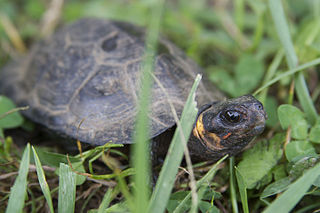
The bog turtle is a critically endangered species of semiaquatic turtle in the family Emydidae. The species is endemic to the eastern United States. It was first scientifically described in 1801 after an 18th-century survey of Pennsylvania. The smallest North American turtle, its carapace measures about 10 centimeters (4 in) long when fully grown. Although the bog turtle is similar in appearance to the painted or spotted turtles, its closest relative is actually the somewhat larger wood turtle. The bog turtle can be found from Vermont in the north, south to Georgia, and west to Ohio. Diurnal and secretive, it spends most of its time buried in mud and – during the winter months – in hibernation. The bog turtle is omnivorous, feeding mainly on small invertebrates. The bog turtle is the state reptile of New Jersey.

The southeastern shrew is a species of mammal in the family Soricidae. It is found in the southeastern United States.

Glyptemys is a genus of turtles in the family Emydidae. It comprises two species, the bog turtle and wood turtle, both of which are endemic to North America. Until 2001, these turtles were considered members of the genus Clemmys, which currently has one member, the spotted turtle.

A scarecrow is a decoy or mannequin that is often in the shape of a human. Humanoid scarecrows are usually dressed in old clothes and placed in open fields to discourage birds from disturbing and feeding on recently cast seed and growing crops. Scarecrows are used around the world by farmers, and are a notable symbol of farms and the countryside in popular culture.

Lycaena epixanthe, also known as the bog copper or cranberry-bog copper, is a North American species of butterfly in the family Lycaenidae. Adults like to sip drops of dew clinging to leaves and almost exclusively nectar on their host plant, cranberries. Because of this, bog coppers will spend their entire lives within the area of a single acid bog. Even though their flight is weak and close to the ground, bog coppers are hard to catch because of the habitat in which they live. Also, 85% of the bog coppers life span is spent in the egg. It is listed as a species of special concern in the US state of Connecticut.
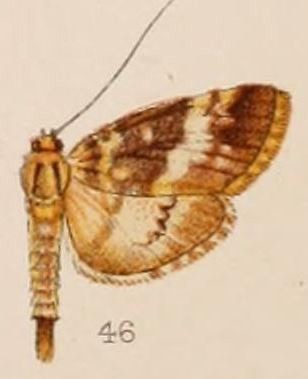
Lygropia is a genus of snout moths in the subfamily Spilomelinae of the family Crambidae. It currently comprises 66 species, which are mostly found in the tropical and subtropical regions of the Americas, Africa and Asia, but not in Australia.
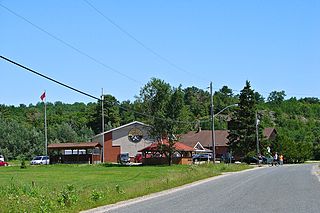
The Serpent River First Nation, a signatory to the Robinson Huron Treaty of 1850, is an Anishinaabe First Nation in the Canadian province of Ontario, located midway between Sault Ste. Marie and Sudbury along the North Channel of Lake Huron.
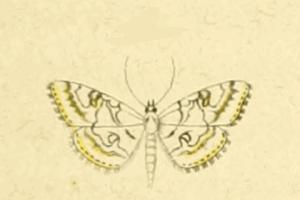
Elophila rivulalis is a species of moth in the family Crambidae. It is found in the Netherlands, Belgium, France, Germany, Poland, Austria, Hungary, Croatia, Italy and Greece.

Endothenia hebesana, the verbena bud moth, is a species of moth of the family Tortricidae. It is found in North America, where it has been recorded from Massachusetts, New York, New Jersey, Pennsylvania, Maryland, Virginia, North Carolina, Florida, Texas, Ohio, Indiana, Missouri, California, British Columbia, Alberta, Manitoba and Ontario. The habitat consists of black spruce-sphagnum bogs.

Conchylodes octonalis, the eight-barred lygropia moth, is a snout moth in the family Crambidae. It was described by Zeller in 1873. It is found in North America, where it has been recorded from central and southern California to Texas and from Iowa, Mississippi, Nevada, New Mexico, Oklahoma and Tennessee. The habitat consists of low-elevation arid areas.

Lygropia plumbicostalis is a species of moth in the family Crambidae. It was described by Augustus Radcliffe Grote in 1871. It is found in the United States, where it has been recorded from Arizona, Florida and Texas.
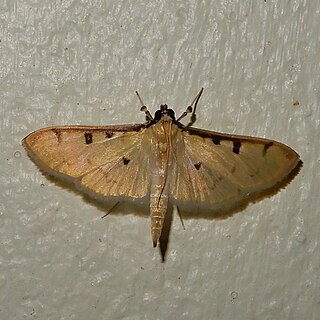
Lygropia tripunctata, commonly known as the sweetpotato leafroller, is a species of moth in the family Crambidae. It was first described by Johan Christian Fabricius in 1794. It is found in the United States, where it has been recorded from Texas to South Carolina and Florida. It is also found from the West Indies and Central America to Brazil.

Bibarrambla is a genus of moths in the family Depressariidae. It is monotypic, with its only species, Bibarrambla allenella, commonly known as the bog bibarrambla moth, described by Thomas de Grey in 1882. It is found in North America, where it has been recorded from Nova Scotia to Minnesota, North Carolina, New York, Connecticut and Maryland.

Sigma Omicron Epsilon, Inc. (ΣΟΕ), also known as SOE, is a Native American sorority founded in 1997 at East Carolina University in Greenville, North Carolina. It is one of eight fraternities and sororities across the United States that is considered historically Native American.
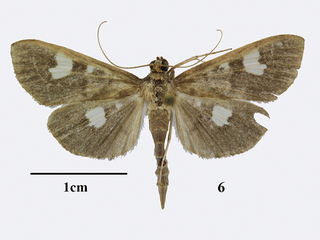
Agroterini is a tribe of the species-rich subfamily Spilomelinae in the pyraloid moth family Crambidae. The tribe was erected by Alexandre Noël Charles Acloque in 1897.

Emer Bog and Baddesley Common is a 50-hectare (120-acre) nature reserve north of North Baddesley in Hampshire. It is managed by the Hampshire and Isle of Wight Wildlife Trust. An area of 39.0 hectares is designated as Baddesley Common biological Site of Special Scientific Interest. An area of 37.6 hectares is designated Emer Bog Special Area of Conservation

Kristin Dutrow Baker is a Republican member of the North Carolina House of Representatives. She has represented the 82nd district since her initial appointment in March 2020.

















